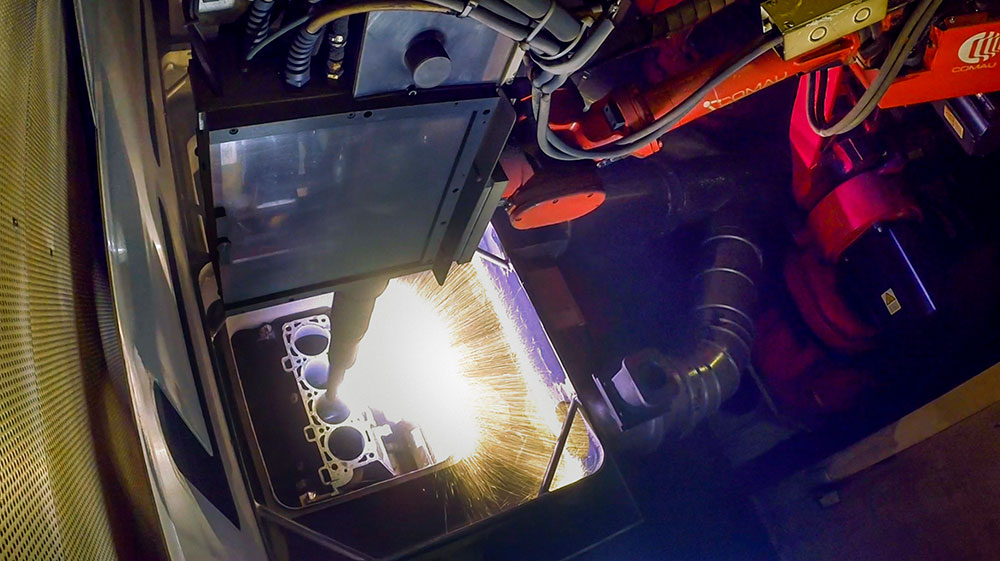The Real Secret Behind Ford’s GT350 Mustang Engine
Forget flat-plane cranks – it’s a new spray-in cylinder liner that makes the ’16 Ford Shelby GT350 Mustang engine really rock. Plasma Transferred Wire Arc saves weight and space, allowing displacement to grow to 5.2L.

WINDSOR, ON, Canada – Much has been written about the wonders of the flat-plane crankshaft in the ’16 Ford Shelby GT350R and GT350 Mustang engines, but the real heroes behind the high-revving 5.2L V-8 are the production engineers at Ford’s Essex Engine Plant here.
After all, without the Plasma Transferred Wire Arc process – PTWA for short – there wouldn’t be an additional 0.2L of displacement in the new V-8, which allows for larger intake and exhaust valves, all of which play a big part in producing 526 hp and 429 lb.-ft. (582 Nm) of torque from the naturally aspirated engine.
“This allowed us to have a higher displacement in the Mustang engine,” says Chris Palazzolo, technical specialist-global engine engineering. “We have a larger cylinder bore in a smaller space.”
Chris Barnes, area manager-5.0L operations, says engineers are “always fighting for space” whether for improved cooling, higher displacement or tighter packaging. With the PTWA process, all three needs are met while seeing a weight savings of about 8 lbs. (3.6 kg) per engine block. Ford says it is the smallest 5.2L block on the market.
PTWA isn’t new to the industry, or even to Ford; the automaker’s GT500 engine was PTWA-treated in Germany by Belgian supplier Honsel International Technologies, and BMW is using it across its new modular engine family. But with the GT350 engine, Ford is bringing the highly complex manufacturing procedure in-house.
How PTWA Works
Using PTWA, Ford replaces typically heavier iron cylinder sleeves with a thin coating of iron/iron-oxide material that is atomized and sprayed on the cylinder walls by a hydrogen-argon gas-plasma arc-welding torch spinning at 400 rpm as it is robotically guided into each cylinder, explains Tim Beyer, technical specialist-global advanced manufacturing engineering.
The welder, fed by a continuous strand of 0.0625-in. (1.5-mm) iron wire delivered at a rate of 252 ft. (77 m) per minute, applies the coating in several layers in about 2 minutes per bore, Beyer says.
After the material is applied, it is allowed to cool and then is machined and honed to a finished thickness as thin as 0.004 in. (0.10 mm), compared to 0.08 in. (2 mm) required for an iron cylinder insert.

PTWA produces durable cylinder liners no thicker than human hair.
Besides being lighter and thinner than an iron liner, the PTWA coating is harder, longer-lasting and reduces cylinder-wall friction, Palazzolo says. “The durability is really outstanding,” he says. “You can still see cross-hatching (from honing) after 200,000 miles (321,869 km).”
Another bonus is that the liner can be applied only where it is needed, so no iron material is sprayed at the top of the cylinder wall, allowing for easier and less expensive finish milling of the top of the aluminum block.
Ford’s automated system treats two engine blocks at a time, producing six to eight blocks per hour and about 48 per day, compared to 600 5.0L blocks per day using traditional iron liners. For now, production is small, but it can be scaled up as demand for the 5.2L engines increases.
The 5.2L blocks are cast at Comtech Manufacturing in Guelph, ON, Canada, and sent in partially machined form to the Essex plant, where they undergo the PTWA process before being shipped back to Comtech for final honing.
The blocks then go to Ford’s engine plant in Romeo, MI, for final assembly.
About the Author
You May Also Like





